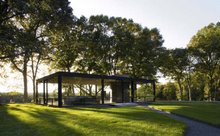Since we have been keeping the hours of 8am-10pm I am merging two blogs from the days. I have been capturing some of the hilarious quotes (which may be conveyed quite flat outside of context) as well as my amateur observations about the Schinkel, Behrens, Mies trilogy.
First let's just start with a bit of description of our group - the Society of Architectual Historians. As mentioned an esteemed group of herding photographers and intellectuals. Never have I been crowded out of a shot of doorhardware until now. A searing gaze from an SAH member as you step near the corner features of a drain pipe can literally set one back 2 years in esteem (if you were so fragile). Of course like any travelling band of marauders we have developed our own sense of family, community and characteurs. Frasier is the photog - first on the scene at the hardware, corners and vistas; Phyllis is the barb; 4 long-married couples who gently play off one another; Monty is the hip young talent, Mr Ed is the eager intellectual, Brian the man with the dry humor zingers- the list goes on and on. I'm sure I'm the caffeinated lurker as I try not to ask too many questions as each house our leader gets peppered with: is this more Persius or Schinklesque? Who owns the note on that development? What was the rate on the note? Etc etc.....
But at this point our little community is saying stuff like: "not another damn pergola" "imagine that - another excedra" "seen one mies you've seen them all" - which was a starting quote but now clearly not true as we have been exploring the early Mies's and he clearly didn't pop out of the womb as a modernist (or execute in that exact style).
In the past 2 days we have seen a number of the earliest Mies homes - including his very first professional commission - Haus Riehl. This home is in the section outside of berlin which was separated to the east and is only now undergoing its renaissance at the assistance of resident "investors". (Taking 2-10 years to research and restore their homes). Mies was 21 - and given his young position and lack of experience, the Riehls sent him to Italy to look at the work being done. As in the other dozen early commissions, Mies has a very trational style (eyebrow windows, shutters, classical axes) but is working out the use of geometry for order and embellishment, sharp insets for bookshelves, windows and other features, and creating a space which extends to the edge of the land - creating a near premontory. This house is english country charming with the whisper of other ideas in its bones.
All in all once you see house Riehl, house Mosler (his largest commission - and still very traditional), house Urbig (also traditional), house Eichstaedt (traditional), house Werner (yep you guessed it - traditional), and house perls (can you believe we have seen all of these?).
What is interesting, it seems, is that Mies is accommodating his clients traditional needs, doing what he knows, and the work which inspires him toward the modern is - oddly - Schinkel. It is Shinkel's stark classicism and formal set-up which simplifies Mies' outside pillars and sets up his symmetry. Namely the new pavilion at Charlottenburg (Schinkel) which is a square, with inset balconies, strict symmetry and continuous movement between inside and outside spaces.
That single fact - the relationship between nature and living - defines Schinkel's sans souci Charlottenhof Palace - which is later emulated in both Behrens and Mies. Thus the trilogy. The living/dining room extending from inside to the veranda, on axis to the fountain and excedra (aka curved bench) - all at Schinkels palace - would be found at nearly every early Mies home we have seen. So there you have it armchair travellers - inside, outside, down the line to a cap. It has worked for years.
Some of the other extraordinary buildings we have seen - which advise the context of the time - are: the turbine factory by Behrens in 1909 (artistic sucess in steel and glass construction and reshaping use); villa wiegand by behrens (so you know he was Mies' employer and a design bridge from schinkel to mies' emerging modern style); to Mendelsohn's einstein tower from 1921 (and amorphic telescope observatory set into a surprising landscape).
So one of the funnies was the discussion about what Frank Lloyd Wright was doing at the time of all this transition toward modernism - and we figured he was off with his mistress in europe. One of the wise cracks being "yes that is a new service being built into the standard architectural contract."
About Preserve the Modern
- . . . . . . . . . . . . . . . . . . . . . . . .
- Preserve the Modern is an initiative led by the Philip Johnson Glass House to focus attention and resources on our nation’s collection of significant Modern buildings in order to document, preserve and protect them. This forum will allow a network of modernists around the world to share their travel experiences visiting modern structures in our region, across the United States, and around the globe. By sharing these modernist travel experiences we aim to raise awareness of these structures as important representations of ideas, lifestyles, as well as cultural and political events that transformed the twentieth century.
Wednesday, August 22, 2007
Subscribe to:
Post Comments (Atom)

No comments:
Post a Comment